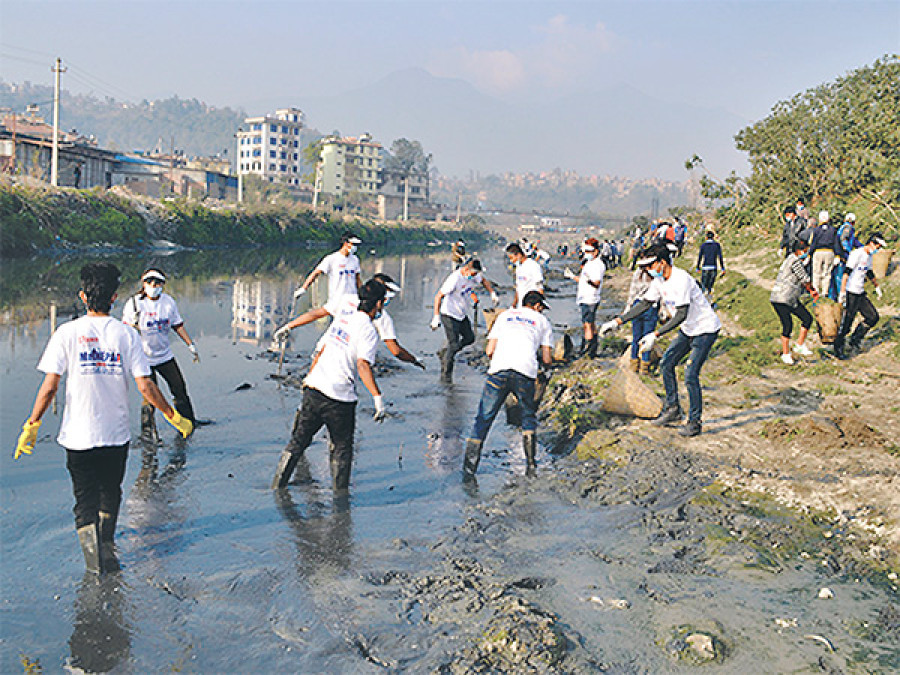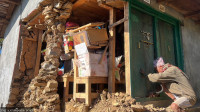Opinion
Bagmati bachao
Authorities should base the Bagmati clean-up on a scientific plan to live up to the legacy of Huta Ram Baidya
Ananta R. Baidya
Thirty years later, my father, the late Huta Ram Baidya’s singular, dedicated, and passionate crusade to restore the Bagmati River has gained momentum. The 100th week of the Bagmati Clean-up Campaign was celebrated on Saturday. This necessary and laudable movement should continue. But will it be sufficient?
The choked, suffocated, and polluted Bagmati affects the health and wellbeing of the residents of Kathmandu. As the Bagmati degrades, the Valley’s valued civilisation, culture, identity, and heritage are threatened with irreversible destruction.
Popularly known as ‘Bagmati Ba’, my father’s commitment to restoring the Bagmati and its civilisation was unwavering. His uncompromising fundamental principal was ‘No encroachment of any portion of the waterways along the historical and heritage sites’. He believed that the use of appropriate science and technology could honour and restore the river system; greed would not. He warned about the conflict between ‘Laxmi Dasis’ and ‘Saraswati Bhaktas’. Unfortunately, current development patterns appear to permit and encourage further encroachment of the river. And to justify encroachments, Bagmati Ba’s name and image has been used dishonestly and without permission.
After proofing a piece, entitled ‘Natural Cure for the Bagmati’, published in The Rising Nepal in August 2012, my father championed the concept of temporarily and seasonally damming the Chobhar gorge to restore the river naturally.
Perhaps, a newer generation will bear his torch. A successful restoration of the Bagmati rests on younger generations who can comprehend its significance.
The unfulfilled wish
As if leaving behind a roadmap for these future stakeholders before he died, my father left hand-written instructions on how to carry out his cremation journey. Whether he was frustrated with his inability to successfully restore the Bagmati or not, the note was his final effort to save the Bagmati. The map of the journey begins from his ancestral residence at Tripureswor to Teku Dovan. The first layover would be at the unique Bramahanaal at Kalamochan Ghat. The final goodbye would be to travel the entire length of the historic ghat to Teku Dovan.
A 45-minute exploratory walk along the prescribed route revealed the utter neglect the Bagmati River system had endured. Gardens and farmlands, roads and football fields, shops and residences—all encroached the riverbanks on both sides. Both the government and civilians were guilty of encroachment. Untreated and hazardous toxic waste was dumped into the river. Significant historical monuments, temples, maths, statues, and heritage sites awaited destruction. Weeds camouflaged the Kalamochan Bramahanaal and the crumbling ghats. Destroyed bakharis remained as sentinels. The abused river bed bled, scoured and misused. The Teku Dowan cremation complex was in shambles. It had turned into a haven for drug addicts, infested with dirty needles. There were goats grazing on the cremation areas. The adjoining crematorium remained dysfunctional.
Fulfilling his last wish proved unpractical and unsafe. The family remained frustrated and disgusted with the unpleasant reality of the route. My father, who wanted a clean Bagmati, could not receive his desired, dignified cremation at the place where the ‘holy’ Bagmati and Bishnumati rivers converge. For safety and logistical reasons, his last rites were performed at the Pashupatinath temple. Our spiritual leaders concurred.
Uncivilised Kathmanduites
After the funeral, the family accompanied the Chief Secretary, officials, activists, and environment experts on the prescribed route. Surprise, the Brahmahanaal was cleared of vegetation and the pathways sprayed with lime powder. There was even talk of the significance of historical sites.
Public events, in which the authorities took a bath in sandbagged lagoons, and the clean-ups every week are brilliant media fodder. But will the use of sandbag dams and clearing the river segment-by-segment resolve the many restoration issues? How many fish that the authorities released into the polluted Bagmati have survived? Such irresponsible, misguided efforts waste precious resources and question modern science.
An established politician blamed ‘uncivilised Kathmanduites’ for the Bagmati’s woes. But during his tenure, he did little to use the resources and opportunities available only to the government to restore the Bagmati. Such provocative, hypocritical public statements demonstrate the failure to understand the essence of the Bagmati. It shows the politicians’ misplaced priorities, selfishness and greed.
60 year ago The Asian Development Bank and Non-Resident Nepalis (NRNs) have committed Rs 120 million for the restoration of the Bagmati. Such contributions, used transparently, can restore the ghats, maintain their historic characteristics, and preserve the waterways. Judicious planning and engineering can solve the problem of the Valley’s drainage system, which currently dumps household and industrial waste directly into the river.
Any effort at restoring the Bagmati that ignores conflicting issues will fail. Piece-meal approaches will not work. Only a comprehensive restoration plan, with
coordinated priorities and transparent actions will succeed.
Promenades, as planned by the government, degrade historic ghats. Instead, restoring the health of the waters, reconstructing the ghats and other historical structures, and removing buildings that encroach on the riverbanks will draw everyone to the banks of the river. Only this way, the Bagmati promenade will be able to provide relaxation and recreation for visitors and tourists alike.
Recently, the Nepali Times published a 60-year-old photo of a pristine Bagmati taken by Tony Hagen. The river stretched across from ghat to ghat. Facebook lit up with comments: “Oho kasto ramro recha ta”, “Feri yesto banla ta?” The Bagmati could be restored to what it was like 60 years ago if the public compels the government to complete the restoration process based on scientific plans.
Today’s High Powered Commission on the Bagmati has to be responsible and accountable to the public. It has to be neutral, and a powerful and selfless watchdog. It has to use donor contributions towards a tangible, resulted-oriented project. But convincing a silent and skeptical public and the government remains challenging. Still, authorities and stakeholders must champion the restoration of the glorious history of the Bagmati river, including the ghats, and other heritage sites. Only then, the sacrifices of the late Huta Ram Baidya will not have been in vain.
Baidya, the son of the late Huta Ram Baidya, is an engineer




 11.12°C Kathmandu
11.12°C Kathmandu










